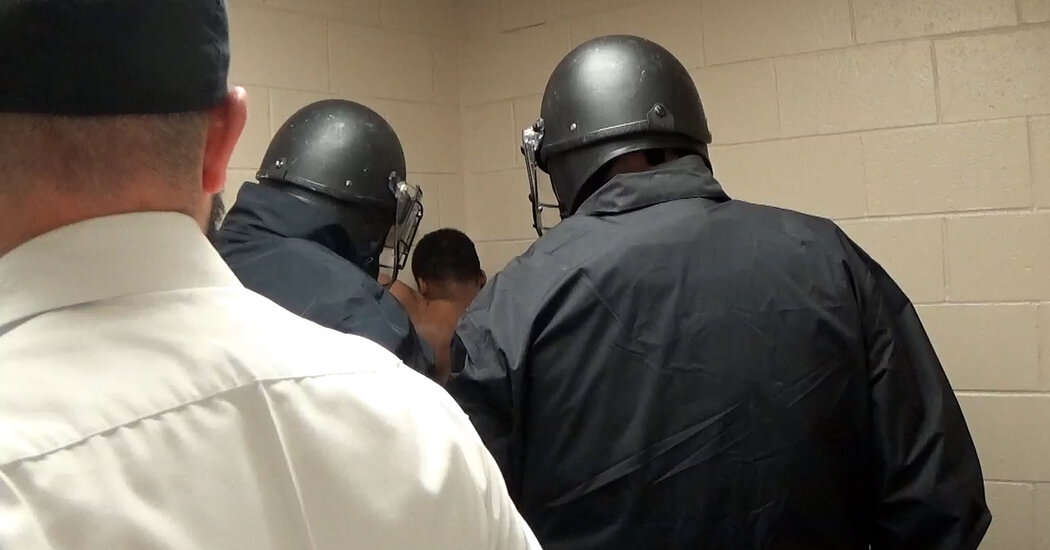Ernastiaze Moore had been an inmate at Sullivan Correctional Facility in upstate New York for 11 days, he said, when an officer there gave him an ominous warning: “We are going to show you how we do it up in Sullivan.”
Soon after, in January 2023, Mr. Moore was in his cell when guards blasted him with pepper spray, burst in, beat him bloody and brought him to a so-called frisk room, where, he said, they groped his genitals and shoved fingers into his anus.
Afterward, Mr. Moore needed surgery to reconstruct his left eye socket, records show. He reported what happened as a case of sexual assault and, in September, he filed a federal civil rights lawsuit accusing the guards of sexual abuse, excessive force and other offenses.
Mr. Moore, who was five years into a 21-year sentence for attempted murder and attempted assault, is one of scores of New York State prisoners who have complained over the years about being mistreated by guards. But his claims have emerged at a time of intense scrutiny for the prisons, where, in the past year, two inmates were beaten to death by guards in separate attacks. Those incidents led a state prosecutor to take the rare step of bringing criminal charges against 20 of the guards involved.
The outcome of Mr. Moore’s internal complaints, however, was more familiar: The New York Department of Corrections and Community Supervision deemed them to be unfounded, and the guards who were involved were not punished.
A spokesman for the department, Thomas Mailey, said an internal investigation had found that the guards did not insert anything into Mr. Moore’s anus and that their handling of him had been “consistent with the type and amount of force justifiably used and reported by staff.”
What sets Mr. Moore’s case apart from others like it was that much of what happened to him was recorded on a hand-held camera by a corrections officer who was required under departmental policy to film the encounter, known in the system as a “cell extraction.”
A New York Times review of the video shows that the episode began with one guard calmly explaining that officers were about to remove Mr. Moore from his cell because they believed he had a knife. (Ultimately no weapon was recovered.)
The Times has annotated portions of the video, which is about 25 minutes long, showing key moments as the encounter unfolded. Some of the scenes include graphic imagery.
First, one guard shoots pepper spray into the cell and four guards in black tactical gear rush in.
It is impossible to see what the guards do to Mr. Moore as they pile on top of him, and a supervising officer blocks the camera’s view. But when Mr. Moore emerges from the cell, his hands are cuffed behind his back, his left eye is swollen shut and blood is dripping down his face.
Mr. Moore tells the officers he is unable to walk and that he is suffering from back pain. (At another point in the video, he says he has multiple sclerosis, although he acknowledges not being diagnosed with it.) They put him on a stretcher and take him to the frisk room.
“You’re going to stand up, you’re going to get stripped, you hear me?” a guard yells at him.
Inside the room, his face against the wall, the guards order Mr. Moore, who is bleeding, to take off his T-shirt, then his pants and shoes and then one sock at a time. They tell him to sit on a “boss chair” — a body-orifice scanner.
Shortly after he is made to stand again, they turn him around, look into his mouth and then tell him to face the wall.
“Lean against the corner,” a guard says. “Drop your boxers.”
One guard turns toward the others and makes a hand gesture, and one of them responds with a similar gesture.
The guard says he has found “a string hanging from the anus area.”
As Mr. Moore objects and falls to the floor, the footage becomes jerky and chaotic. Mr. Moore can be heard screaming six times that officers are punching him in the face, and that the guards are forcibly touching his genitals and anus.
The sergeant supervising the search repeatedly tells Mr. Moore to “stop resisting,” although Mr. Moore does not appear to be doing so.
A spatter of blood is visible on the wall behind him as an officer discards Mr. Moore’s bloodstained underwear and is handed a new pair.
In the end, they did not find anything hidden in his body.
Mr. Moore said in an interview that he was just “trying to survive” during the strip search.
“I was hopeless — like dang, nobody ever did this to me before,” he said. “It was just frustration and anger.”
Afterward, the guards threw away Mr. Moore’s bloodied boxer shorts. Mr. Mailey, the Corrections Department spokesman, said the underwear was not considered evidence and was “contaminated with chemical agents as well as blood.” He added that any bleeding from Mr. Moore’s anus was caused by Mr. Moore himself, accusing him of trying to hide an unspecified item in his body, and not by guards.
Mr. Moore’s lawyers accused the guards of disposing of evidence.
“This is part of a systemic pattern where correctional officers are protected, not punished, regardless of the harm inflicted,” one of the lawyers, Nicholas Liakas, said in a statement.
The guards took other steps to cover up what they had done, the lawyers said. When members of the prison’s medical staff examined Mr. Moore alongside his cell, they remained present and even threatened him with more violence if he reported what had happened, the lawsuit said.
Three months later, after a nurse filed the sexual assault complaint on Mr. Moore’s behalf, the guards referred him to the mental health observation unit, where one of the officers who had participated in the episode was stationed, the lawsuit says.
Eventually, after Mr. Moore went on a weekslong hunger strike to draw attention to his case, the prison system’s internal investigators interviewed him, the lawsuit says.
Two days later, two officers cornered him in the shower, called him a racial slur and said they knew he had been speaking with investigators, the suit says. They put him in handcuffs, beat him and pinned him to the floor, the suit says. Then they shoved what Mr. Moore believed to be either a pen or a radio antenna into his rectum as one of the guards said: “Are you going to stop reporting me now?”
In a statement, Mr. Mailey said the Corrections Department had reviewed those accusations as well and had found evidence, including medical evidence, video footage “and/or witnesses,” that refuted them.
Sullivan Correctional Facility, a maximum-security prison for men about 50 miles west of Poughkeepsie, has been singled out for high rates of abuse by the Correctional Association of New York, a state watchdog group. In 2022, a representative of the organization testified at a hearing that about one in five inmates there had reported being treated violently or abused by staff members.
The prison was closed last fall amid a declining inmate population and as part of the state’s budget plan to reduce the number of penitentiaries in New York.
Mr. Moore is now being held at Mid-State Correctional Facility, the prison where one of the two men killed by guards, 22-year-old Messiah Nantwi, was fatally beaten in March.
Jay Root is an investigative reporter for The Times based in Albany, N.Y., covering the people and events influencing — and influenced by — state and local government.
Jan Ransom is an investigative reporter for The Times focusing on the criminal justice system, law enforcement and incarceration in New York.
Ainara Tiefenthäler is a reporter on The Times’s Visual Investigations team who combines traditional reporting with digital methods to investigate issues of conflict, corruption and human rights.
The post A Bloody Prison Beating Was Caught on Video. No Guards Were Punished. appeared first on New York Times.




